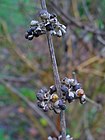Note: This is a project under development. The articles on this wiki are just being initiated and broadly incomplete. You can Help creating new pages.
Vitex agnus-castus - Chastetree
Vitex negundo is a large aromatic shrub with quadrangular, densely whitish, tomentose branchlets. It is widely used in folk medicine, Traditional medicine , particularly in South and Southeast Asia.
Contents
- 1 Uses
- 2 Parts Used
- 3 Chemical Composition
- 4 Common names
- 5 Properties
- 6 Habit
- 7 Identification
- 8 List of Ayurvedic medicine in which the herb is used
- 9 Where to get the saplings
- 10 Mode of Propagation
- 11 How to plant/cultivate
- 12 Commonly seen growing in areas
- 13 Photo Gallery
- 14 References
- 15 External Links
Uses
Breast tenderness, PMS, Menstruval cramps, Menopause, Prostate cancer
Parts Used
Chemical Composition
Cineole,C10H17O. Iridoid glycosides, agnoside, aucubin, eurostoside, Flavonoids[1]
Common names
| Language | Common name |
|---|---|
| Kannada | Nochi |
| Hindi | Nirgundi |
| Malayalam | Vennocchi |
| Tamil | Nocchi |
| Telugu | Vavili |
| Marathi | NA |
| Gujarathi | NA |
| Punjabi | NA |
| Kashmiri | NA |
| Sanskrit | Sinduvara |
| English | Chaste Berry |
Properties
Reference: Dravya - Substance, Rasa - Taste, Guna - Qualities, Veerya - Potency, Vipaka - Post-digesion effect, Karma - Pharmacological activity, Prabhava - Therepeutics.
Dravya
Rasa
Tikta (Bitter), Katu (Pungent)
Guna
Laghu (Light), Ruksha (Dry)
Veerya
Ushna (Hot)
Vipaka
Katu (Pungent)
Karma
Kapha, Vata
Prabhava
Habit
Identification
Leaf
| Kind | Shape | Feature |
|---|---|---|
| Simple | Reminiscent | The leaves are very reminiscent of the marijuana plant (Cannabis sativa) and feature five leaflets in a palmately compound arrangement. |
Flower
| Type | Size | Color and composition | Stamen | More information |
|---|---|---|---|---|
| Unisexual | Purple, White | 5 | The purple flower clusters (called panicles) look like those of the butterfly bush (Buddleja spp.) Varieties with white flowers are also available |
Fruit
| Type | Size | Mass | Appearance | Seeds | More information |
|---|---|---|---|---|---|
| Oblong | They look like peppercorns and are sometimes used to flavor food | Four seeds | {{{6}}} |
Other features
List of Ayurvedic medicine in which the herb is used
- Vishatinduka Taila as root juice extract
Where to get the saplings
Mode of Propagation
How to plant/cultivate
Chaste trees need full sun and very well-drained soil. It’s best not to plant them in soil that is rich in organic matter because organically rich soils hold too much moisture close to the roots[3]
Commonly seen growing in areas
Near bodies of water, recently disturbed land, Grasslands, Mixed open forests
Photo Gallery
References
External Links
- Ayurvedic Herbs known to be helpful to treat Breast tenderness
- Ayurvedic Herbs known to be helpful to treat PMS
- Ayurvedic Herbs known to be helpful to treat Menstruval cramps
- Ayurvedic Herbs known to be helpful to treat Menopause
- Ayurvedic Herbs known to be helpful to treat Prostate cancer
- Herbs with Fruit used in medicine
- Herbs with Berries used in medicine
- Herbs with Leaves used in medicine
- Herbs with Stem used in medicine
- Herbs with common name in Kannada
- Herbs with common name in Hindi
- Herbs with common name in Malayalam
- Herbs with common name in Tamil
- Herbs with common name in Telugu
- Herbs with common name in Sanskrit
- Herbs with common name in English
- Habit - Tree
- Index of Plants which can be propagated by Seeds
- Index of Plants which can be propagated by Cuttings
- Herbs that are commonly seen in the region of Near bodies of water
- Herbs that are commonly seen in the region of recently disturbed land
- Herbs that are commonly seen in the region of Grasslands
- Herbs that are commonly seen in the region of Mixed open forests
- Herbs
- Lamiaceae










